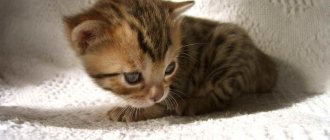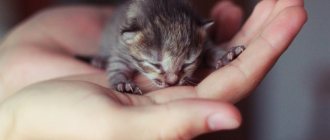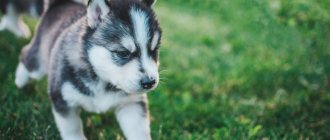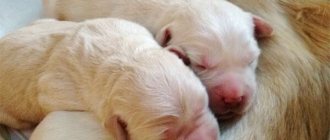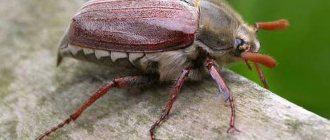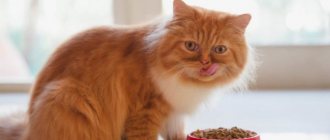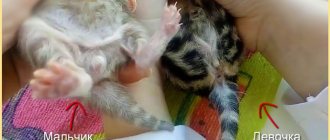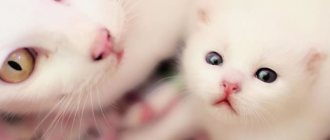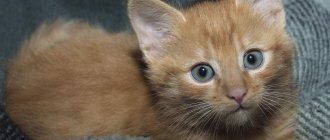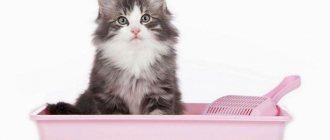14379Pavel
In order to determine how healthy a kitten is, it is very important for future owners and breeders to study the development of kittens week by week. How strong a kitten is, whether it needs additional stimulation of the immune system or care can be determined by recording changes in the development of kittens by day after birth. The correct growth of a small pet depends not only on a properly structured diet, upbringing and training, but also on compliance with the rules that are established for caring for kittens.
Features of development in the first week
Kittens develop especially rapidly in the days after birth. After birth, he weighs no more than 100 grams and gains about the same amount in the first week. Underweight or excess weight directly affects development, so you need to monitor it and regularly weigh your pet.
During the first 3 days of life, as a rule, the umbilical cord falls off, which the cat can care for independently. But in order to prevent the occurrence of inflammation, kittens are recommended to treat the umbilical cord in the first days of life with a weak solution of potassium permanganate.
A newborn kitten is always blind and begins to see only after three weeks from birth. Few people know such a feature as congenital deafness, which disappears only by 5 days after birth. A deaf baby does not even respond to his mother's voice.
It is especially important to arrange a place for the cat in advance so that small kittens during the period of deafness can easily find their mother . The development of kittens from birth occurs very rapidly; it is during this period that he receives his first food in the form of mother's milk, which ensures that all necessary microelements and nutrients enter the body. Natural nutrition is very important for the development of a kitten, since it also includes antibodies that the baby needs to form immunity.
© shutterstock
Although the baby does not see or hear in the first days of his life, he perfectly uses his sense of smell, with the help of which he identifies his mother. Kittens are born with a sense of smell that allows them to find a cat, even if it is within a radius of 60 centimeters from the kitten. In order to ensure the proper development of the kitten, it is necessary to prepare a place for the cat in which drafts and sudden changes in temperature will be completely excluded. This will not only protect the baby from colds, but also provide comfortable conditions for growth.
What to feed babies
The best food for small kittens is cat milk replacers. However, they are quite expensive, and it is not always possible to find a fresh product. In such cases, a good option for complementary feeding would be:
- Goat milk – pre-boiled and diluted 50% with clean water. Adding a teaspoon of sugar and egg yolk (per 0.5 liters of milk) will help enrich the product with useful substances and vitamins.
- Infant milk formulas , however, it is important to pay attention to the fact that they do not contain various fillers, dyes, flavors, and sugar. The mixture is prepared according to the instructions, in proportions as for a child aged 1-2 weeks. But before feeding, the finished product is half diluted with water.
- Formulas for infant kittens are ideal because they are similar in composition to mother's milk. Only, of course, preference should be given to quality products from trusted brands and src=”https://porodakoshki.ru/wp-content/uploads/2019/08/Kak-kormit-kotyat-v-2-nedeli-e1565139834249.jpg” class=”aligncenter” width=”600″ height=”400″[/img]
Cat milk replacers are available in both powder and liquid forms. They are quite easy to prepare, especially since each product package comes with instructions that help not only decide on the recipe, but also choose the optimal daily dosage. This product can be used for complementary feeding in cases where a nursing cat does not have enough milk or as babies grow older.
Development over 2 weeks
During the second week of his life, the baby grows and develops, which is reflected in his indicators:
- weight increases to 250 grams;
- the auricle, which was poorly developed before this age, is fully formed and the kitten begins to respond to extraneous noises, as well as the cat’s meow;
- by the end of the second week, the eyes may open;
- communication skills improve, and kittens begin to communicate not only with each other, but with their mother, which affects their development.
During this period, breeders and owners of kittens allow them to be picked up without fear that the cat will abandon her babies. However, the development of even a healthy baby cannot guarantee a sufficiently strong skeleton at this age, so you need to handle them carefully and without causing them additional inconvenience.
A feature of the psychological development of kittens at this age is that they urgently need not only the attention of the cat, but also communication with their brothers. After all, it is in the first month of life that the baby’s character and his ability to establish contact are formed.
Before 3 weeks, it is not recommended to look at the kittens very often and often pick them up. This can affect the psychological development of small pets, and the cat may behave aggressively, thus showing protection.
Possible ways to feed kittens
At the age of 2 weeks, it is extremely important to pay special attention to the correct algorithm for feeding kittens:
- Place . The baby should be placed on his knees, with a disposable diaper or polyethylene placed under his abdomen, and his head should be slightly raised. Most owners note that the most convenient place for feeding is a small box with sides. The baby needs to be placed on the bottom of the box so that his front paws rest against the side, lift his head by the scruff of the neck and start eating.
- Inventory . For feeding you need to use pipettes, disposable syringes and bottles. In this way, nutrition will enter the baby’s body drop by drop, as evenly and safely as possible. If the kitten's sucking reflex is poorly developed, it is better to replace the bottle with a nipple with a syringe or pipette. Using a syringe requires taking a number of precautions. Firstly, it is best to equip the syringe with a rubber tip, which reduces the likelihood of traumatic injury. It is important to teach the kitten to lick the mixture from the syringe, since it is impossible to completely introduce it into the oral cavity of small pets due to increased trauma to the gums and mucous membranes of the oral cavity.
- Head position . It is important that when feeding, the kitten's head is in a straight position and its paws are down. It is advisable for the baby to suck the milk himself. Therefore, you need to try not to pour food into the kitten’s mouth.
- Feeding rules . You need to feed slowly, without haste or fuss, so that the kittens do not choke.
Development in the third week
During the third week, all kittens' eyes open. However, vision is not yet good enough to navigate in space. It is necessary to monitor all physiological changes to ensure that the development of kittens corresponds to their age and to promptly eliminate irritating factors that may interfere with normal growth.
The main stages of development of newborn kittens take place in the first three weeks, as their body is actively growing and all the organs of smell and touch are formed. It is at the age of three weeks that kittens first try to stand on their paws and their teeth appear.
© shutterstock
The formation of the jaw will take up to two months. From the third week, you can safely accustom the baby to your hands, constantly play with him and stroke him, and in order to let the pet know that the owner is also one of his friends, in addition to the other kittens and the mother.
Rare colors
Amber is a new and not yet approved species. Externally similar to golden, but more subdued. The peculiarity is the presence of single black hairs located nearby.
Doubts about color are caused by the fact that dark stripes or dots are visible against a warm background, and cats, not at the genetic level, can be either black or red. For now, Amber is recognized in one of the felinological organizations for the Kuril Bobtail breed.
Kittens with the rare fawn color are a gift for many breeders. It is a variation of lilac, but a very light shade. The color of the nose is beige and pink, as are the pads on the paws. Eyes amber or copper.
This is a monochromatic color, the pigment in the hairs is evenly distributed. The quality of British wool should not suffer from bleaching, despite its apparent softness.
Cinnamon or cinnamon is a derivative of the chocolate color. The color is solid and uniform, without blemishes or marks. The shade is delicate, slightly muted. The color of the nose of the cinnamon is brownish-pink.
There are two types of shade: yellow and red. It is layered on top of the base brown. The paw pads are colored similarly to the nose.
Development at 5-6 weeks
During this period, it is recommended to carry out the following activities:
- show it to a veterinarian for the first time, who will record the level of development and prevent developmental delays;
- The baby should be actively transferred to artificial nutrition and given no more than 100 grams of wet food daily;
- organize your own place for each of the kids;
- show kittens to direct buyers or purchase a baby by booking it in advance at the nursery.
During this period, it is recommended to organize six meals a day, which will include no more than 100 grams of food per meal. Such nutrition will allow the baby to correctly go through all stages of kitten development and become sufficiently strong. It is recommended to be attentive to the prevention of various parasites and carry out timely vaccination and deworming.
How to weigh a kitten correctly
If the kitten is very small, then in order to weigh it, you can use a regular kitchen scale and a small box. To prevent the kitten from turning weighing into a game, the best time for the process is immediately after sleep. If the baby starts spinning and jumping, the indicators will be inaccurate. Trying to hold a playful baby with your hand can also get a distorted result.
To get the most accurate figure for the baby’s weight, you can follow two methods:
- First, weigh the box, then put the kitten in it and record the result again. Subtract the difference.
- Place the box on the scales, and only then turn them on. They will show zeros. After this, we put the baby in a box and get the figure for his body weight.
It is more convenient to weigh mobile kittens in small containers or boxes to get a more accurate result.
This way the owner will receive an exact figure in grams, which can be entered into the animal’s weight diary.
Video: how to weigh a cat
In the third month from birth
As a rule, at this age, all processes slow down a little and the main focus is on adapting to a new home. From three months the baby's character begins to emerge. Also during this period, the baby becomes completely independent, responds to his nickname and does not need the constant presence of his mother.
He learns to build relationships with his new owner and adapts to living conditions . Considering that at this age your pet will be quite inquisitive, you should limit its access to all dangerous places in the house, including electrical appliances. At the end of 3 months, it is recommended to carry out repeated deworming.
The diet during this period must be fully formed and established, and the owners must decide what type of food they will prefer for their baby: natural food or dry or wet food.
Eye color standards
Each breed has a personal accepted standard for eye color. These are quite strict rules that should not be broken.
So, which breeds have strict restrictions on eye color:
- Abyssinian cat. This breed can only have green or yellow eyes.
- Burmese cat. This beauty's eyes can only be light gold.
- Burmilla. Green of any intensity.
- Balinese. Blue or blue eyes.
- Bombay cat. Only deep copper eye color.
- Burmese cat. Exceptionally bright blue eye color.
- Havana brown. Green or yellowish-green.
- Egyptian Mau. The eyes are light green (gooseberry color).
- Korat. Amber or amber-green eyes.
- Kao-mani. Yellow or blue eyes.
- Lykoy. Yellow or amber eyes.
- Nibelung. Only gooseberry eye color.
- Oriental cat. Green eye color is preferred.
- Ojos azules. Only blue eyes.
- Pixie bob. The eyes are gooseberry-colored, brown or yellow.
- Russian blue cat. Exceptionally green eyes, from light to rich emerald.
- Ragdoll. Only blue eyes.
- Siamese cat. Blue or blue eyes.
- Tonkinese cat. Aquamarine, blue or yellow eye color.
- Thai cat. Only deep blue eye color.
- Turkish van. Only gold or blue.
- Chausie. Yellow, copper, hazel or green eye color.
- Chartreuse (Carthusian cat). Copper, orange or amber eyes only.
The standard of some cat breeds allows them to have only a certain eye color (pictured are Havana Brown cats)
In some breeds, eye color may depend on coat color:
- British cats of the black solid, blue solid, cinnamon, fawn, and lilac colors cannot be green-eyed or blue-eyed.
- British Chinchillas and British Goldens can only have green eyes.
- White Turkish Angoras can only be blue-eyed, green-eyed, or yellow-eyed.
- In Oriental cats, yellow and blue are allowed in solid (solid) colors and blue in color-point colors.
Some interesting facts about eye color in cats:
- A Sokoke cat can change eye color depending on its mood.
- Very often, blue-eyed cats (especially white ones) are deaf.
- All cat lovers know that the blue-eyed gene in purring cats is recessive. However, in cats of the Ojos Azules breed, this gene somehow mutated into a dominant one. They can also be green-eyed or yellow-eyed. Also, deafness is not associated with the Ojos blue-eyed gene and they cannot be bred with other blue-eyed cats.
- All color-point cats can only be blue-eyed or blue-eyed. Their eyes absorb all colors of the rainbow spectrum except blue. They reflect it and therefore appear blue-eyed. But the brightness of blue depends on the amount of pigment: the more pigment there is, the paler the color of the cat’s eyes. In very rare cases, Color Points may have yellow eyes.
- If a cat has no pigment in her eyes, she will be red-eyed. This only occurs with albinism.
- Albinos can also have blue eyes (this is called partial albinism).
- As surprising as it may sound, outbred cats usually have much richer eye color than many purebred cats.
Abyssinian cats most often have green eyes
Development from the fourth to the sixth month
During this period, it is recommended that he trim his claws for the first time; it is necessary to monitor the following indicators:
- height, which will depend on breed and gender;
- weight, which must be at least 1.4 kg;
- constant activity and good socialization.
Until six months, it is not recommended to give the baby food that is intended for adult cats, as it will not provide the necessary development and the intake of all necessary microelements.
Up to six months, it is recommended to adhere to five meals a day, which ensures good functioning of the gastrointestinal tract and stable development of your kitten. At the end of 6 months, the baby's teeth will begin to change. This age is most optimal for castration. It is advisable to carry out a third deworming in order to eliminate the presence of parasites in your pet’s body. In the sixth month, it is recommended to switch the baby to three meals a day, which corresponds to his level of development.
© shutterstock
Where would we be without vitamins?
When artificially feeding, the kittens' diet must include specialized supplements and vitamin complexes to compensate for the deficiency of those substances that babies receive from mother's milk. A veterinarian will help you choose the right drug and determine the dosage.
Special supplements that are well suited for 2-week-old babies include:
- Trivit (1 drop each);
- glucose (1 to 2 g during feeding);
- bone and meat flour (an excellent source of calcium for bones, tooth enamel and joints and ligaments of children);
- fish oil (1 drop once a week) – perfectly enriches the body with vitamins D;
- vitamin A;
- vitamin E;
- vitamin D;
- a preparation containing B vitamins.
It is important to take into account the fact that ready-made cat milk substitutes and formulas already contain a certain amount of vitamins, and most supplements are designed for kittens one month and older.
An excess of substances can be just as dangerous to the health of children as their deficiency, so it is necessary to correctly calculate the optimal dosage of each drug.
Development from 9 months to a year of life
During this period, the kitten is fully formed, its development is almost complete, and it continues to turn into an adult pet, increasing in size and gaining weight.
At 10 months of age, you can start switching your baby to adult food. However, this must be done gradually, mixing it with baby food.
Timely trimming of nails and dental care, as well as visits to the veterinarian will ensure the correct development for your baby and will allow you to adjust your upbringing and diet so that your pet grows healthy, active and receives all the necessary care.
Colors of Shorthair Scottish Fold cats (Scottish Fold Colors)
White (WHITE)
: Pure white, shiny. Eyes: deep sapphire blue or gold. A white with different eyes should have one eye sapphire blue and the other golden with equal color saturation. Nose and paw pads: pink. Black (BLACK)
: Black, coal without any rusty mixture.
Painted along the entire length. Nose is black. The pads are black or brown. The eyes are golden. Blue (BLUE)
: blue, preferably light blue, uniform.
Equally darkish is preferable to light with transitions and shades throughout the body. The nose and pads are blue. The eyes are golden. Red (RED)
: deep brilliant red, uniform, without smoke, pattern or ticking (at least see this in person, reds always have smoke, tabi, etc.).
White hairs are not allowed. Nose and pads: brick red. The eyes are golden. Cream (CREAM)
: Light shades are preferable, the color is uniform throughout the body. Nose and paw pads: pink. The eyes are golden.
